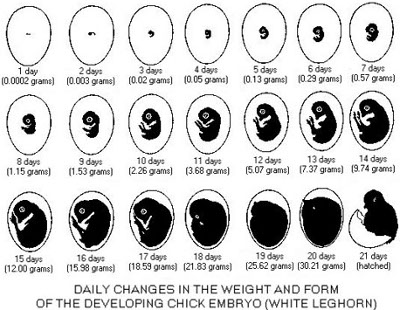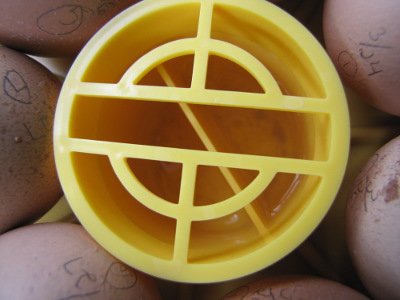 With our wildly varying
With our wildly varying
spring temperatures, it took a week for me to figure out how to adjust
the nearby heater to keep our incubator running on an even keel.
The low temperature alarm went off on the first night and the high
temperature alarm went off on the third afternoon and the ninth
night. I’m sure these temperature variations will affect my hatch
rate, but I’m actually quite pleased with the combination of the Brinsea
Mini Advance Incubator‘s
high-tech temperature control and our
supplemental space heater — there was much less
temperature variation than I’ve ever managed before! I’ll count
this first try a success if we get even one living chick.
 With
With
that goal in mind, it’s finally time to prepare for the hatch.
Except for keeping the temperature even, my only job during the first
two and half weeks of incubation was to keep one of the wells inside
the incubator full of water — it tended to need refilling every three
days. On day 19, I filled both wells with water so that the
humidity inside the incubator would rise from 40-50% to 65% or
more. It’s essential to have high humidity during hatch time so
that the chicks won’t get stuck in the shell and die. I left the
pot guard on all along, but now’s also the time when you need to put
that small insert in place to keep chicks from drowning.
The automatic egg turner
feature on the incubator keeps track of days to hatch and stops turning
at day 19 (which will read as day 2 on the count-down window.)
When the eggs stop turning, it’s best to remove the egg disc insert and
put a piece of paper on the floor of the incubator underneath the eggs
instead. (Be sure to cut a circle out of the center to fit around
the water well.) Paper on the floor of the incubator gives your
chicks easier footing and also makes the incubator much easier to
clean.
When you stop turning
the eggs at day 18, each chick will be manipulating its location in the
egg so that its head can
point toward the air pocket at the blunt end of the egg. By day
19, the chick will have poked its beak into the air pocket and will be
starting to breath air, and soon thereafter you might be able to hear
the chick peeping in the shell. The chick can now start pecking
its way out of the shell (pipping), which it may do any time between
day 19 and day 22. This period is toughest since you’ll get best
results if you leave the incubator completely closed between day 19 and
the time when all of the chicks are hatched and fully fluffed
out. I’m looking forward to the challenge!
